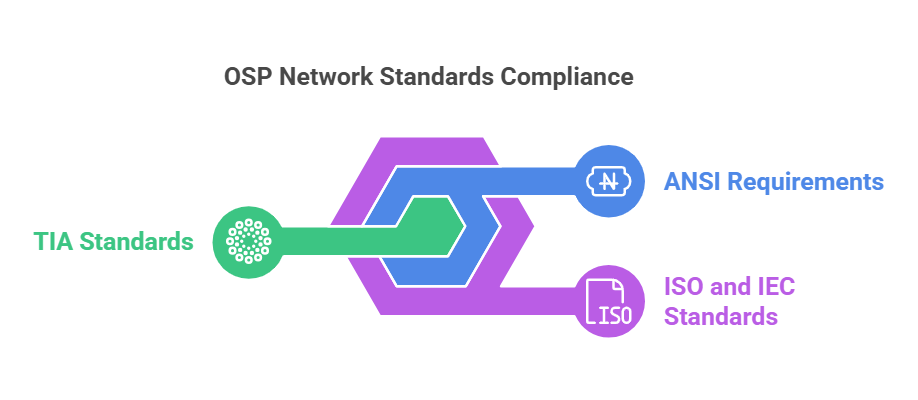Outside Plant Standards and Compliance
Adhering to industry standards and legal compliance is a critical aspect of any OSP (Outside Plant) project. Compliance ensures not only the safety and reliability of network infrastructure but also its long-term success. This page will explore the key regulatory bodies, safety guidelines, and why strict adherence to these standards is essential for every OSP project.
The Importance of Standards and Compliance in OSP Projects
In the world of Outside Plant (OSP) projects, adhering to industry standards and legal compliance is not just a best practice—it’s essential for ensuring the success and longevity of the network. Strict compliance to safety regulations, design standards, and construction protocols minimizes risks, enhances reliability, and ensures that the final infrastructure meets both operational and regulatory expectations.
Ensuring Safety and Reliability in OSP Networks
Safety and reliability are paramount in OSP projects, and adhering to industry standards helps ensure both. Compliance with established standards provides a framework for the safe installation and operation of fiber optic, copper, and other network components. This includes ensuring that construction practices, material usage, and installation methods are aligned with regulations that prevent hazards and minimize the risk of accidents.
Reliable network performance also relies on following these standards, which help guarantee the quality of materials, connections, and maintenance practices. Following safety guidelines reduces the likelihood of damage to equipment or infrastructure, which can lead to costly repairs and service interruptions.
Minimizing Legal and Financial Risks Through Compliance
Legal and financial risks are significantly reduced when OSP projects comply with relevant standards and regulations. Non-compliance can lead to a range of consequences, from project delays and fines to legal liabilities, especially if the work doesn’t meet local, state, or federal regulations. For example, violating safety codes or environmental regulations can result in penalties or the need for costly rework.
By following established standards, OSP projects stay on the right side of the law, reducing the chances of lawsuits, fines, or regulatory actions. Moreover, compliance ensures that projects stay within budget and on schedule, making it easier to manage costs and avoid unexpected financial burdens. This proactive approach to compliance not only helps prevent issues but also boosts the long-term viability of the network.
Key Regulatory Bodies Governing OSP Projects
The Role of the Federal Communications Commission (FCC)
The Federal Communications Commission (FCC) plays a pivotal role in regulating OSP networks, particularly in areas related to telecommunications infrastructure. The FCC ensures that service providers adhere to national standards for network operations, spectrum use, and communication services. It also establishes rules that govern the installation, maintenance, and expansion of broadband and other communication technologies, particularly in public right-of-ways and near sensitive infrastructure. Compliance with FCC regulations is essential to avoid penalties, maintain licenses, and ensure the safe operation of network systems.
Understanding OSHA Guidelines for Workplace Safety
The Occupational Safety and Health Administration (OSHA) provides regulations designed to protect workers in OSP projects, particularly those involved in aerial and underground installations. OSHA guidelines cover a wide range of safety concerns, including fall protection, electrical hazards, personal protective equipment (PPE), and excavation safety. Ensuring compliance with OSHA standards is crucial for preventing accidents and maintaining a safe work environment, ultimately reducing the risk of injury, fatalities, and legal ramifications associated with workplace safety violations.
State and Local Regulations Impacting OSP Work
In addition to federal regulations, OSP projects must comply with state and local laws that can vary widely depending on the jurisdiction. These regulations may cover everything from the issuance of permits for excavation or installation to restrictions on working hours or environmental impact assessments. Local governments may also have specific guidelines regarding the use of public property or right-of-ways, as well as the restoration of sites after construction. Understanding and adhering to these state and local regulations is key to avoiding costly fines, delays, and legal challenges that could arise during the project lifecycle.
Industry Standards for OSP Design and Construction
Telecommunications Industry Association (TIA) Standards
The Telecommunications Industry Association (TIA) is a leading authority in the development of standards for telecommunications infrastructure, including Outside Plant (OSP) networks. TIA’s standards provide detailed guidelines for the design, installation, and maintenance of telecom networks, ensuring they meet industry best practices and performance requirements. One of the most well-known TIA standards is the TIA-568 series, which outlines specifications for fiber optic cabling and network design, promoting uniformity and interoperability across the industry. Adhering to TIA standards helps guarantee that OSP networks are reliable, efficient, and scalable for future growth.
American National Standards Institute (ANSI) Requirements
The American National Standards Institute (ANSI) serves as a key body in the development and approval of voluntary consensus standards in the U.S. ANSI works closely with other organizations, including TIA, to ensure that OSP network designs and construction meet national requirements for performance, safety, and compatibility. ANSI standards are essential for defining the criteria for materials, equipment, and procedures used in OSP projects. By adhering to ANSI’s regulations, companies ensure their networks meet rigorous quality control standards while maintaining compliance with national codes and regulations.
International Standards from ISO and IEC
The International Organization for Standardization (ISO) and the International Electrotechnical Commission (IEC) develop global standards that impact OSP network design and construction. ISO standards are crucial for setting guidelines for overall network quality, including environmental and sustainability factors, while the IEC focuses on electrical and electronic components used in network infrastructure. Compliance with ISO and IEC standards ensures that OSP projects meet international best practices, facilitating easier integration with global networks and ensuring that the systems are adaptable to future technological advancements. Adopting these international standards also positions OSP networks for broader adoption and use, ensuring a higher level of quality and interoperability on a global scale.

Safety Guidelines for OSP Projects
Importance of Personal Protective Equipment (PPE)
Personal Protective Equipment (PPE) is a fundamental part of ensuring safety on OSP job sites. For workers involved in the installation, maintenance, and inspection of Outside Plant networks, PPE provides essential protection against a wide range of potential hazards, including electrical shock, falling debris, and harsh environmental conditions. The most common types of PPE used on OSP projects include hard hats, safety glasses, high-visibility clothing, gloves, and steel-toed boots. In some cases, additional PPE such as hearing protection, respiratory protection, and fall protection gear may also be required depending on the nature of the work. Ensuring that all personnel wear the proper PPE helps minimize the risk of injury and ensures that safety regulations are met.
Identifying and Mitigating Job Site Hazards
Job sites for OSP projects can pose various risks due to the nature of the work, the tools involved, and the surrounding environment. Common hazards include working at heights, handling heavy equipment, digging trenches, and working with live wires or underground cables. Identifying these hazards early and mitigating them effectively is crucial to maintaining a safe work environment.
To reduce risks, job site assessments should be conducted regularly to spot potential hazards, such as uneven terrain, poor weather conditions, or electrical dangers. Effective hazard mitigation measures may include securing proper barriers for excavations, using proper lifting techniques, establishing safe zones for working near high-voltage areas, and ensuring proper lighting for night work. Clear safety protocols should be established, and emergency response plans should be in place to deal with accidents should they occur.
Training and Certification Requirements for OSP Teams
The safety and effectiveness of OSP projects depend heavily on the skills and knowledge of the workforce. Comprehensive training programs and certifications are essential to ensure that all team members understand the specific safety protocols and technical requirements involved in OSP work.
Certifications from recognized organizations, such as the National Safety Council (NSC) or Occupational Safety and Health Administration (OSHA), help verify that workers are adequately trained in safety practices and industry standards. Workers should be trained in proper equipment handling, hazard recognition, and emergency response procedures. Regular safety training sessions, along with ongoing education about updates in safety guidelines and industry standards, help keep teams informed and prepared. This ensures that OSP projects are not only compliant with safety regulations but also conducted in a way that minimizes accidents and promotes long-term health and safety for workers.
Why Compliance is Critical for Long-Term Success
Enhancing Network Longevity and Performance
Compliance with industry standards and regulatory requirements plays a pivotal role in enhancing the longevity and performance of an OSP network. When a network is built and maintained in accordance with established best practices and safety standards, it is more likely to function efficiently over the long term, with fewer issues related to degradation or failure. Proper installation, regular maintenance, and adherence to regulations help mitigate common risks like equipment failure, environmental damage, and service interruptions. As a result, compliant networks tend to have longer lifespans, greater reliability, and fewer costly repairs, ensuring that the infrastructure continues to meet performance expectations for years to come.
By following the appropriate standards during design, construction, and maintenance, OSP projects reduce the likelihood of issues such as signal loss, network congestion, and physical damage that can affect the network’s operation. Furthermore, it allows for seamless future upgrades or expansions without compromising the integrity or functionality of the existing infrastructure.
Building Trust with Stakeholders Through Adherence
Adhering to industry standards and compliance regulations also plays a crucial role in building and maintaining trust with stakeholders, including clients, contractors, regulators, and the public. When an OSP project is compliant with legal and safety requirements, it demonstrates professionalism, commitment to quality, and a proactive approach to risk management. This fosters positive relationships with stakeholders who depend on the network’s performance and safety.
For clients, knowing that a project is built in accordance with the highest standards ensures that they are receiving a reliable, efficient solution that complies with all necessary regulations. Similarly, regulatory bodies and local authorities will view compliant projects as low-risk, reducing the chance of legal disputes or regulatory scrutiny. For the OSP provider, adherence to these standards enhances their reputation and credibility, making it easier to secure future projects and establish long-term business relationships.
Partnering with DataField for Standards-Compliant OSP Projects
Our Expertise in Regulatory Compliance and Safety
At DataField, we specialize in ensuring that all aspects of Outside Plant (OSP) projects adhere to the highest standards of regulatory compliance and safety. With years of experience in the industry, our team understands the intricacies of local, state, and federal regulations, as well as the importance of following best practices for network design, construction, and maintenance. From obtaining the necessary permits to ensuring that our work meets or exceeds industry standards, DataField takes a meticulous approach to compliance. Our expertise ensures that your OSP project will meet all legal, environmental, and safety requirements, minimizing the risk of costly delays or fines.
Proven Success in Delivering Standards-Compliant OSP Networks
DataField has a strong track record of delivering OSP projects that are not only technically sound but also fully compliant with regulatory and safety standards. We have successfully completed numerous projects for clients across various industries, ensuring that each one meets or exceeds the requirements set by regulatory bodies such as the Federal Communications Commission (FCC) and the Occupational Safety and Health Administration (OSHA). Our commitment to compliance has resulted in seamless project execution, reduced risks, and enhanced network performance for our clients. When you partner with DataField, you can be confident that your OSP network will be built to last, with safety and compliance at the forefront of every decision.
Ready to Ensure Compliance for Your OSP Project?
Partnering with DataField for your OSP project means working with a team that prioritizes regulatory compliance, safety, and quality. Whether you’re designing, constructing, or maintaining an OSP network, our team is here to ensure that every aspect of your project adheres to the latest industry standards and regulations.


